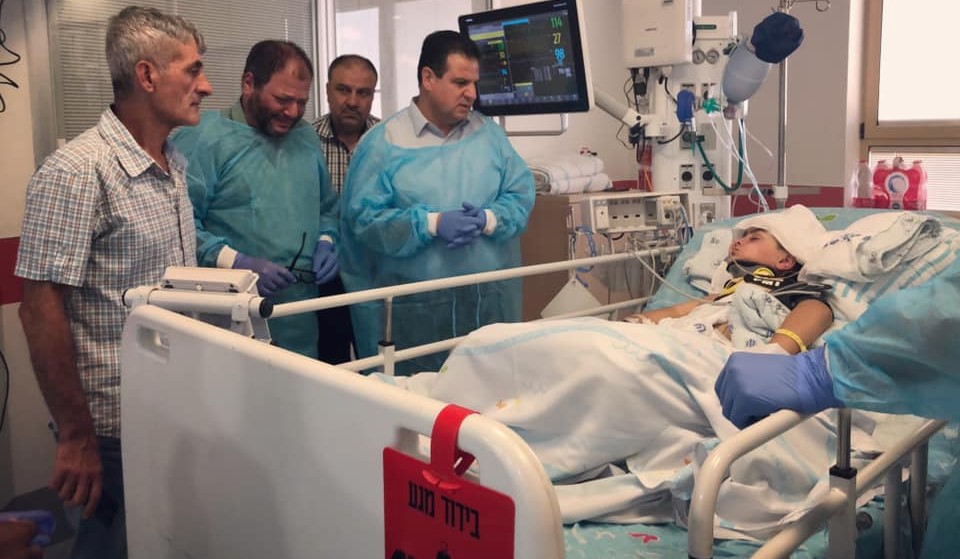An investigation by B’Tselem published on Friday, July 19, establishes that an Israeli soldier, firing live ammunition, hit Abd Rahman Shteiwi, age 9, in the head critically wounding him a week earlier. This is in stark contrast to the statements issued by the Israeli military till then regarding the circumstances that led to the boy’s critical wounding.
Shteiwi was shot on Friday, July 12, while playing in the entrance to a home in Kafr Qadum, in the West Bank, during the weekly demonstration in the village against the occupation. Now hospitalized in critical condition, Shteiwi is the latest victim of the reckless open-fire policy that allows Israeli soldiers to use live fire even when neither they nor anyone else is in any danger.

MK Ofer Cassif (second from left), in tears, beside MK Ayman Odeh, during their visit to the bedside of Abd Rahman Shteiwi in the intensive care unit at Sheba Hospital in Tel Hashomer, Saturday, July 20 (Photo: Zu Hederech)
At about 1:30 PM on Friday, July 12, the regular weekly demonstration against the closure of the main access road from Kafr Qadum to the regional capital Nablus took place. The military blocked the road in the early 2000s, following the expansion of the adjacent settlement of Kedumim. Since then, residents have been forced to use a bypass road that lengthens the journey by about half an hour.
During the demonstration soldiers fired rubber coated metal bullets at the protestors, but, in a departure from previous practice in Kafr Kadum protests, this time, they also fired a large number of live rounds in the air. At a distance of about 200 meters from the main protest, about ten protestors threw stones at four soldiers who were a few dozen meters away from them, on another hill on the same ridge. About 100 meters away from this group, further down the road, a resident of Kafr Qadum was sitting under an olive tree with his two 10-year-old children. Opposite them, about 10 meters away Abd Rahman Shteiwi was sitting at the entrance of one of the homes on the edge of the village playing with a piece of wood.
At about 2:20 PM, as the main demonstration began to disperse, some 200 meters away from Shteiwi, a soldier fired a live bullet. It hit the boy’s head and he immediately fell to the ground. The resident who was sitting nearby and a young man who was in the area evacuated the boy to an ambulance waiting some 50 meters away down the road. Abd Rahman was taken unconscious to Rafidia Hospital in Nablus where he underwent head surgery. Two days later, on July 14, sedated and respirated, he was transferred to the intensive care unit at Sheba Hospital in Tel Hashomer in Israel.
In its statements to the media, the Israeli military denied that soldiers used live fire, and even rejected any responsibility for the incident. A response the military released claimed that the soldiers had used “various crowd-control methods” and that “a report was received of an injured boy aged around ten.” According to B’Tselem, 9-year-old Abd Rahman Shteiwi’s injury is “a direct result of the open-fire policy implemented by the military in the Occupied Territories. This policy illegally and without any justification permits the use of live fire against Palestinians who are not endangering anyone. The policy remains in force despite the fact that it has resulted in hundreds of Palestinian deaths and thousands of injuries.”
The Israeli military prides itself on regulations restricting the circumstances in which live fire may be used, while at the same time claiming that its law enforcement system will take action against soldiers who violate the regulations. However, these statements are hollow and meaningless. In many cases, the open-fire regulations are completely disregarded. Meanwhile, the law enforcement system is actually a whitewashing system intended to create the illusion of investigations. “Shteiwi is the latest victim of this policy, but unless it is changed, it is only a matter of time before the next victim is added to the list,” said Hadash MK Ofer Cassif.


